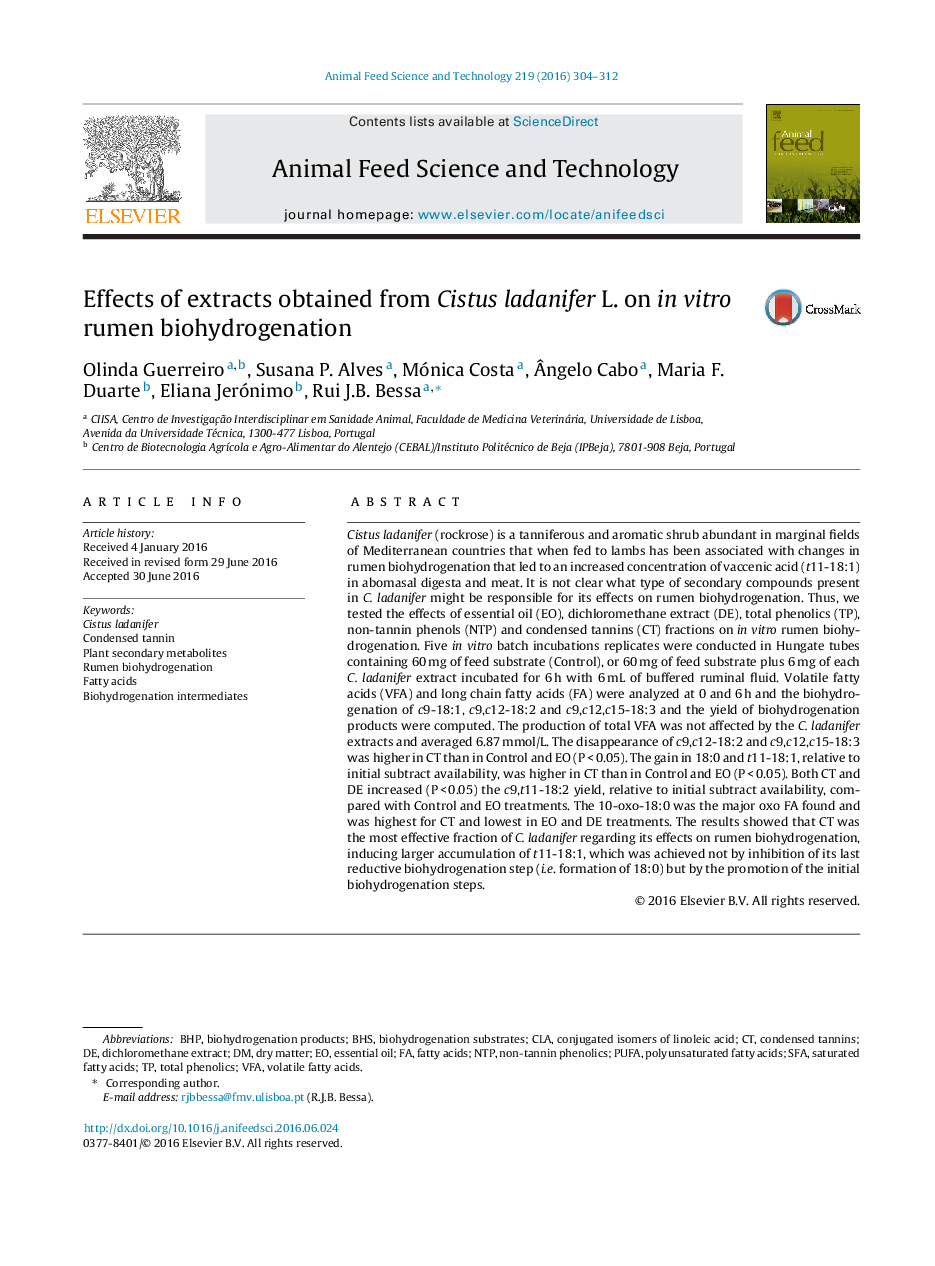| کد مقاله | کد نشریه | سال انتشار | مقاله انگلیسی | نسخه تمام متن |
|---|---|---|---|---|
| 8491149 | 1552366 | 2016 | 9 صفحه PDF | دانلود رایگان |
عنوان انگلیسی مقاله ISI
Effects of extracts obtained from Cistus ladanifer L. on in vitro rumen biohydrogenation
دانلود مقاله + سفارش ترجمه
دانلود مقاله ISI انگلیسی
رایگان برای ایرانیان
کلمات کلیدی
VFADichloromethane extractbiohydrogenation intermediatesCistus ladaniferBHSSFACLANTPPolyunsaturated fatty acids - اسید چرب اشباع نشدهPUFA - اسید چرب چند غیراشباعFatty acids - اسیدهای چربsaturated fatty acids - اسیدهای چرب اشباع شدهVolatile fatty acids - اسیدهای چرب فرارbhp - بشکه ایRumen biohydrogenation - بیو هیدروژن رامنCondensed tannins - تانن های متراکم یا تانن های فشردهCondensed tannin - تانن چگالEssential oil - عطرمایه یا اسانسdry matter - ماده خشکPlant secondary metabolites - متابولیت های ثانویه گیاهیTotal phenolics - کل فنولیک
موضوعات مرتبط
علوم زیستی و بیوفناوری
علوم کشاورزی و بیولوژیک
علوم دامی و جانورشناسی
پیش نمایش صفحه اول مقاله

چکیده انگلیسی
Cistus ladanifer (rockrose) is a tanniferous and aromatic shrub abundant in marginal fields of Mediterranean countries that when fed to lambs has been associated with changes in rumen biohydrogenation that led to an increased concentration of vaccenic acid (t11-18:1) in abomasal digesta and meat. It is not clear what type of secondary compounds present in C. ladanifer might be responsible for its effects on rumen biohydrogenation. Thus, we tested the effects of essential oil (EO), dichloromethane extract (DE), total phenolics (TP), non-tannin phenols (NTP) and condensed tannins (CT) fractions on in vitro rumen biohydrogenation. Five in vitro batch incubations replicates were conducted in Hungate tubes containing 60Â mg of feed substrate (Control), or 60Â mg of feed substrate plus 6Â mg of each C. ladanifer extract incubated for 6Â h with 6Â mL of buffered ruminal fluid. Volatile fatty acids (VFA) and long chain fatty acids (FA) were analyzed at 0 and 6Â h and the biohydrogenation of c9-18:1, c9,c12-18:2 and c9,c12,c15-18:3 and the yield of biohydrogenation products were computed. The production of total VFA was not affected by the C. ladanifer extracts and averaged 6.87Â mmol/L. The disappearance of c9,c12-18:2 and c9,c12,c15-18:3 was higher in CT than in Control and EO (PÂ <Â 0.05). The gain in 18:0 and t11-18:1, relative to initial subtract availability, was higher in CT than in Control and EO (PÂ <Â 0.05). Both CT and DE increased (PÂ <Â 0.05) the c9,t11-18:2 yield, relative to initial subtract availability, compared with Control and EO treatments. The 10-oxo-18:0 was the major oxo FA found and was highest for CT and lowest in EO and DE treatments. The results showed that CT was the most effective fraction of C. ladanifer regarding its effects on rumen biohydrogenation, inducing larger accumulation of t11-18:1, which was achieved not by inhibition of its last reductive biohydrogenation step (i.e. formation of 18:0) but by the promotion of the initial biohydrogenation steps.
ناشر
Database: Elsevier - ScienceDirect (ساینس دایرکت)
Journal: Animal Feed Science and Technology - Volume 219, September 2016, Pages 304-312
Journal: Animal Feed Science and Technology - Volume 219, September 2016, Pages 304-312
نویسندگان
Olinda Guerreiro, Susana P. Alves, Mónica Costa, Ãngelo Cabo, Maria F. Duarte, Eliana Jerónimo, Rui J.B. Bessa,